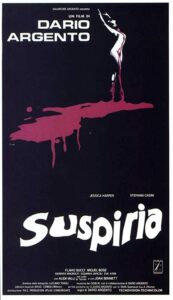In the lead up to the November release of the remake, a revisit of Dario Argento’s 1977 horror classic, “Suspiria,” is in order.

 Don’t kid yourself, even after 41 years, “Suspiria” is still a scary movie. In my youth, I remember watching it on VHS. Back then, on a television set that was no larger than 27 inches, I would have watched it in some cropped version that, when combined with low resolution and generation loss, failed to give the rich visuals the respect they deserved.
Don’t kid yourself, even after 41 years, “Suspiria” is still a scary movie. In my youth, I remember watching it on VHS. Back then, on a television set that was no larger than 27 inches, I would have watched it in some cropped version that, when combined with low resolution and generation loss, failed to give the rich visuals the respect they deserved.
Now, taking it in on a larger screen with an aspect ratio closer to its native 2.35:1, I was able to more closely appreciate the artful approach that director Argento and his team took in crafting what really is a landmark piece of horror cinema. And despite the fact that I watched the strangely dubbed version, the eerie score combined with an odd ADR dialogue track enhanced the creepy factor.

In “Suspiria” a young New Yorker named Suzy Bannion (Jessica Harper) travels to the Tanz Dance Academy, a ballet school in Germany, where she is to study advanced dance. Stepping off the plane, she exits the terminal into a torrential downpour. From the very beginning, Argento uses sound design to make even mundane activities seem dangerous and sinister. For example, the sound of the sliding glass doors as Suzy walks out of the terminal is piercing and that is followed by the disturbing echos of the storm that completely dominates.
After struggling but finally flagging down a taxi, the delicate Suzy arrives at the school. At the front door, she encounters a terrified, young woman, who, in the throes of mania, says something nonsensical. The woman then runs hysterically from the building and into the storm. Suzy will later see the woman staggering frantically through a wooded area. This mystery deepens for Suzy, when she is turned away from the school and must stay elsewhere for the evening. She will be welcomed with open arms the next day, but Suzy learns that the frightened woman has been murdered. And without spoiling it, the woman’s grisly murder is an impressively staged event. Argento flexes his Italian horror giallo muscles early, tapping out some terrifying beats.

In time, Suzy grows more and more suspect of the school’s vice-directress Madame Blanc (Joan Bennett) and her second in command Miss Tanner (Alida Valli). And there will be more murders, of course. One especially riveting sequence features expert use of razor wire as a victim struggles to escape. The excruciating bloody images of pain, captured in a grandly dramatic, but skillful and artful manner, will stick with you.

Argento’s use of color stands out, as he uses striking shades of red, green and blue effectively. Those colors are integrated perfectly into the lush set design that towers over everything. And cinematographer Luciano Tovoli is given time to put it all on display. There are shots in this film in which the camera just lingers, giving us a full often unobstructed view of a location. An empty hallway, a large pool featuring two lone swimmers, a ballet studio alive with dancers, it’s all there on vivid display. The depth of the rich production and meticulous attention to detail puts the viewer in that place. If there are flaws in the design, I didn’t notice any. Argento had no fear–he shows so much. This wide open approach gives the viewer a real feel for the labyrinthian school, which is one of the narrative’s key haunting players.

But the images wouldn’t have seemed nearly as foreboding if not for the fantastic score. Argento worked with Italian progressive rock band Goblin, with whom he collaborated on his previous film “Deep Red,” to compose unnerving synth led music that saturates the film. It’s really potent, and, at times, sets your teeth on edge, even when nothing is really happening on screen. Of course, there is always the possibility that something will happen, as the “Suspiria” mystery keeps you guessing.

Some viewers will be distracted by the effects in the film’s concluding act. And the blood, there’s plenty of it, is an almost fluorescent red, an other-worldly color. But back in 1977, I suspect that few complained. Practical effects can be really effective, even when they look arguably fake. For example, in one sequence, Suzy is tormented by a vampire bat. And the winged creature is clearly some kind of puppet. However, the sequence goes on and on, with a relentless, aggressive attack. It’s long enough to wear you down. I thought, “that damned bat could be a puppet animated by the supernatural.” It really doesn’t matter, because it becomes frightful, as the little beast tries to bite and terrorizes Suzy.

I think the length of this fight, and its bloody resolution, is part of Argento’s genius. It’s deliberate pacing that builds tension to a breaking point. Like the arguably languid location shots that establish the setting vividly, Argento stays with his uncompromising vision, making no apologies for slow parts.
On November 2, 2018, the long-awaited “Suspiria” remake will grace theaters. The new version has the “Call Me by Your Name” team of director Luca Guadagnino and cinematographer Sayombhu Mukdeeprom. Suzy (or Susie) is played by Dakota Johnson and Tilda Swinton plays Madame Blanc. Radiohead frontman and terrific composer Thom Yorke does the music. The trailer is below.
